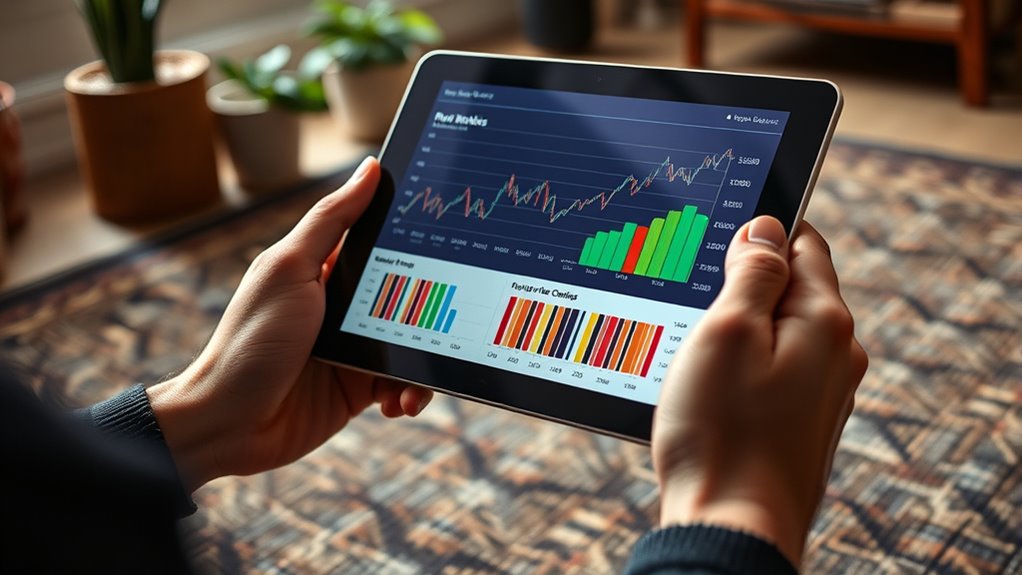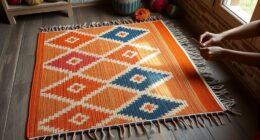To understand rug market indexes and price charts, focus on key components like trend lines, support and resistance levels, and volume indicators. Look for patterns such as upward or downward trends, color shifts, and peaks to gauge market direction and health. Recognizing fluctuations and supply-demand signals helps predict future movements. If you keep exploring, you’ll get better at interpreting these tools to make smarter buying or selling decisions.
Key Takeaways
- Analyze color patterns, trend lines, and volume indicators to interpret market direction and momentum in rug price charts.
- Identify support and resistance levels by noting repeated peaks and troughs, aiding in predicting price movements.
- Recognize fluctuations in material quality and color shifts to gauge market stability and changing consumer preferences.
- Monitor demand signals such as sales trends and online interest to assess industry health and emerging trends.
- Avoid overreliance on trend lines alone; cross-reference multiple indicators and external factors for accurate market analysis.
Understanding Rug Market Indexes

Have you ever wondered how rug prices are determined across different markets? Rug market indexes help answer that by reflecting current trends and shifts in pricing. These indexes are built through market segmentation, categorizing rugs by type, quality, origin, and customer segment. This segmentation allows for more accurate comparisons and insights. Pricing strategies play a vital role in how indexes are constructed; sellers adjust prices based on demand, competition, and market conditions. By analyzing these indexes, you can see which segments command higher prices and how overall market values fluctuate. This understanding equips you with the knowledge to anticipate price movements, recognize market trends, and make informed buying or selling decisions. Fundamentally, indexes serve as a snapshot of the complex rug marketplace. Additionally, understanding the impact of AI security in data analysis can help improve the accuracy of market predictions and protect sensitive pricing information. Employing data analysis techniques that incorporate market segmentation enhances the precision of these indexes and provides deeper market insights. Recognizing the importance of environmental impact in the production and sourcing of rugs can also influence market valuations and consumer preferences. For example, incorporating sustainable sourcing practices can appeal to environmentally conscious buyers and affect price points. Moreover, considering consumer behavior allows sellers to better tailor their strategies to current market demands and preferences.
Key Components of Price Charts

Understanding the key components of price charts helps you interpret market movements more effectively. You’ll want to watch for how price movements are visualized, identify trend lines, and spot support and resistance levels. These elements provide vital insights into potential future price actions. Additionally, recognizing market trends can help you anticipate shifts and make more informed decisions. Paying attention to exponential growth patterns can also reveal underlying momentum and help predict future price directions. Observing tuning modifications in related vehicles can sometimes serve as indirect indicators of market preferences and demand shifts. Monitoring technological advancements in the industry can further enhance your analysis of overall market health and future outlooks. Furthermore, incorporating an understanding of price volume correlations can improve the accuracy of market forecasts and trend predictions.
Price Movements Visualization
What are the essential elements that bring price movements to life on a chart? First, color coding helps you quickly identify trends, with different colors representing upward or downward movements. Second, volume indicators reveal the strength behind price changes, showing how much trading activity occurs during shifts. Third, candlestick patterns visually display open, high, low, and close prices, offering detailed insights into market sentiment. These components work together to create a clear picture of how prices evolve. Color coding guides your immediate understanding of bullish or bearish moves, while volume indicators confirm whether a trend has momentum. Additionally, understanding the digital literacy of market participants enhances your interpretation of complex chart signals. Recognizing the influence of preppy dog names and other breed-specific naming trends can also provide unique insights into market behaviors. Developing technical analysis skills further supports more accurate predictions of future price directions. Being aware of behavioral finance principles can help you interpret market psychology and potential reversals. Incorporating market psychology concepts allows traders to better anticipate reversals and confirm trend continuity. By paying attention to these key elements, you can better interpret price movements and make more informed trading decisions.
Trend Line Analysis
Trend line analysis relies on drawing straight lines that connect significant price points to reveal market direction. By identifying peaks and troughs, you can determine whether the rug market is trending upward, downward, or sideways. Paying attention to color patterns helps confirm trend strength or reversals, as consistent color shifts often signal a change in momentum. Material quality also plays a role; stronger, high-quality materials tend to support sustained price movements, while weaker materials may lead to volatility. When drawing trend lines, verify they touch multiple points for accuracy, and observe how these lines intersect with color patterns and material quality signals. Additionally, understanding the role of trusted custodians in safeguarding investments can influence the reliability of the market analysis. Recognizing market dynamics such as supply and demand fluctuations can further enhance your interpretation of trend patterns. Incorporating technical analysis tools, like volume indicators, can also provide confirmation of trend strength and potential reversals. This approach helps you interpret market behavior more reliably, enabling better timing of buying or selling decisions.
Support & Resistance
Have you ever noticed certain price levels where rug prices repeatedly bounce or stall? Those are your support and resistance levels. Support acts like a floor, where buyers step in, often influenced by consistent color patterns or familiar material textures. Resistance, on the other hand, is like a ceiling, where selling pressure halts price rises. To identify these key points, look for:
- Price peaks that occur multiple times, indicating resistance zones.
- Price troughs where prices bounce back, showing support levels.
- Repeated interactions with specific color patterns or textures that reinforce these levels.
Interpreting Market Trends and Fluctuations

Understanding market trends and fluctuations requires paying close attention to price charts and index movements. You’ll notice that shifts in color patterns can signal changing consumer preferences or seasonal demand, helping you anticipate future price movements. Similarly, fluctuations often reflect underlying changes in material quality or supply chain dynamics. When prices rise steadily, it might indicate an increased demand for high-quality rugs, while sharp dips could suggest market saturation or oversupply. By analyzing these trends, you can identify whether the market is trending upward or downward. Recognizing subtle fluctuations in color patterns and material quality helps you interpret the overall market health. This awareness equips you to make informed decisions, whether buying, selling, or holding rugs in anticipation of future market shifts.
Recognizing Indicators of Industry Health

To gauge the industry’s health, you should focus on price trends and how they shift over time. Strong, consistent price increases often indicate growing demand, while fluctuations can signal instability. By paying close attention to these signals, you can better understand the overall market momentum.
Price Trends Analysis
Price trends serve as essential indicators of the rug industry’s overall health, revealing whether demand is rising or waning. To interpret these signals effectively, focus on key factors:
- Color variation: Consistent color shifts may indicate changing preferences or quality concerns, affecting pricing.
- Material durability: Trends toward more durable materials suggest increased value and customer satisfaction, often boosting prices.
- Market stability: Steady price movements reflect balanced supply and demand, signaling a healthy industry.
Market Demand Signals
Monitoring market demand signals provides valuable insights into the overall health of the rug industry. By paying attention to shifts in consumer preferences, you can gauge whether demand is rising or waning. For example, increasing interest in sustainable or handmade rugs indicates evolving tastes, signaling growth opportunities. Retail strategies also reflect industry health; rising inventory turnover and positive sales trends show strong demand. Conversely, slowing sales or excess stock may signal a decline. Tracking online search trends and social media mentions helps identify emerging preferences early. These indicators allow you to adjust your offerings, marketing, and inventory plans accordingly. Recognizing these demand signals helps you stay ahead of market shifts, ensuring your business aligns with current industry health and consumer expectations.
Practical Tips for Analyzing Rug Data

When analyzing rug data, focusing on key indicators can reveal valuable market trends. Start by examining rug material variations, as shifts in popularity often signal emerging consumer preferences. Next, analyze color patterns carefully; changes in dominant hues or motifs can indicate shifting styles or regional demand. Finally, consider the consistency of data over time to identify real trends versus short-term fluctuations. To get a clearer picture, look for patterns such as:
- Increasing demand for eco-friendly materials.
- Rising popularity of bold, contrasting color schemes.
- Consistent growth in specific regional markets.
Common Mistakes to Avoid When Reading Charts

While analyzing rug charts, it’s easy to focus on the data points that stand out, but several common mistakes can lead to data misinterpretation. One mistake is overreliance on trends, which can cause you to see patterns that aren’t actually meaningful. Don’t assume that a trend will continue indefinitely; markets can change suddenly. Another mistake is ignoring context or external factors that influence prices, leading to false conclusions. Also, jumping to conclusions based on short-term fluctuations can mislead you about the overall market direction. To avoid these errors, always cross-reference data, consider longer timeframes, and stay aware of external influences. This careful approach helps you interpret charts accurately and prevents costly misjudgments.
Frequently Asked Questions
How Often Are Rug Market Indexes Updated?
You might wonder how often rug market indexes are updated. Typically, these indexes are refreshed regularly to reflect market volatility and maintain index accuracy. Updates can occur daily, weekly, or monthly, depending on the data source and market activity. Staying current with these updates helps you make informed buying or selling decisions, ensuring you understand the latest market trends and price movements effectively.
What Factors Influence Rug Price Fluctuations?
You should know that rug price fluctuations are influenced mainly by quality craftsmanship and material sourcing. When artisans use high-quality materials and expert techniques, prices tend to rise. Additionally, sourcing materials from reliable suppliers or regions can increase costs, affecting prices. Market demand and rarity also play a role, but your focus on craftsmanship and sourcing directly impacts a rug’s value and its price changes over time.
Can Price Charts Predict Future Rug Market Trends?
You might wonder if price charts can predict future rug market trends. While they show historical pricing and market volatility, they don’t guarantee future movements. By analyzing patterns, you can spot potential shifts, but remember, market volatility means unpredictability. Use charts as a helpful tool, but don’t rely solely on them. Stay informed about other factors affecting the rug market for a more accurate outlook.
How Do Seasonal Changes Affect Rug Prices?
You’ll notice that seasonal changes notably impact rug prices through seasonal demand and production cycles. During peak seasons like fall and winter, demand rises, causing prices to increase. Conversely, in off-peak times, demand drops, leading to lower prices. Producers adjust their output based on these cycles, which influences availability and pricing. By understanding these patterns, you can better anticipate when to buy or sell rugs for ideal value.
Are There Regional Differences in Rug Market Indexes?
Did you know that regional trends can cause rug market indexes to vary by up to 25%? You’ll notice that consumer preferences differ across regions, influencing pricing and demand. In some areas, traditional patterns are more popular, while modern styles dominate elsewhere. These regional differences shape market indexes, helping you understand where to buy or sell for the best value based on local tastes and trends.
Conclusion
By mastering how to read rug market indexes and price charts, you’ll gently navigate the industry’s subtle shifts and quiet signals. With practice, you’ll develop a keen eye for the faint ripples and delicate patterns that hint at future trends. Trust your instincts, stay attentive to details, and over time, you’ll find yourself moving gracefully through market fluctuations, like a skilled weaver weaving a beautiful, resilient tapestry of insight and understanding.









